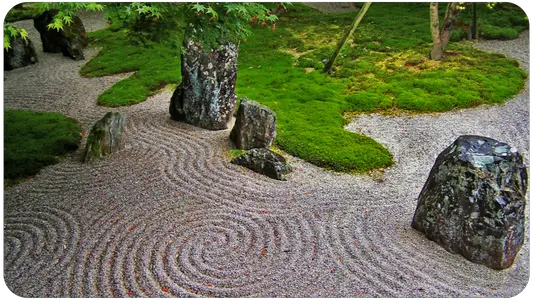Dhyāna (Sanskrit: ध्यान (devanāgarī); Pali: झान, romanization, jhāna; simplified Chinese: 禅; traditional Chinese: 禪; pinyin: chán; Korean: 선, translit. : seon; Zen (禅?); Vietnamese: thiền; Tibetan: བསམ་གཏན, Wylie: bsam gtan, THL: Samten) is a Sanskrit term that corresponds in Patañjali's Yoga Sūtra to the seventh limb (aṅga) of yoga.
This term refers to states of concentration cultivated in Hinduism, Buddhism, and Jainism. It is often translated as "absorption," although etymologically it simply means meditation or contemplation.
The term meditation is used today as a word for many techniques in the West, similar to mindfulness in psychology or philosophy. Historically and for the Indian subcontinent, dhyana is the closest.
Patañjali, the compiler of the Yoga Sūtra, makes it a preliminary stage of samādhi. The two terms are interchanged to refer to these "transcendent" states of consciousness.
For example, the translations Ch'an in Chinese, Sŏn in Korean, Thiền in Vietnamese, and Zen in Japanese are names of schools of Buddhist dhyāna, derived from each other, where dhyāna takes on this strong sense of samādhi.
One more often encounters, in Buddhism, the term pāli jhāna, because the teachings related to it are more a concern of the Theravāda school.
In Buddhism
Therāvada
Attaining the jhānas corresponds to the development of tranquility and wisdom (see Samatha bhavana). There are five jhānas of the pure physical form or sphere, and four jhanas in meditation on the immaterial realms.
Anapanasati is the main technique for accessing the jhānas, metta meditation is another. These jhānas are differentiated according to the "factors" that characterize them:
Initial application (movement of the mind toward the object of meditation): vitakka ;
Sustained application (grasping of the object by the mind): vicāra ;
Joy, rapture: piti;
Happiness: sukha;
Concentration in one point: ekaggata;
Equanimity: upekkha.
To be attained, the jhānas require the removal of five impediments:
sense desire (kāmacchanda);
anger or animosity (vyāpāda);
laziness or torpor (thīna-middha);
agitation or remorse (uddhacca-kukkucca);
doubt (vicikicchā).
The five jhānas of the world of form all involve different factors; their number is often reduced to four (disregarding an intermediate state between the first and second, lacking vitakka, but with a remnant of vicāra):
first dhyâna: vitakka, vicāra, piti, sukha and ekaggata (the world of the five senses is completely transcended) ;
second dhyâna: piti, sukha and ekaggata (there is no more action, no movement of the mind, only joy and happiness are felt).
third dhyâna: sukha and ekaggata (only happiness remains).
fourth dhyâna: upekkha and ekaggata (pure equanimity, there is a temporary stop of breathing in this state).
These two factors, equanimity and concentration, will remain present in the 4 jhānas of the formless or non-physical.
The four immaterial realms of meditation are:
Detailed article: Arupajhana.
the sphere of infinite space
the sphere of infinite consciousness
the sphere of nothingness
the sphere without perception and without non-perception
Mahayana
Chan, soen, thien and zen
Dhyana is a paramita: a perfection or virtue. Chan is the Chinese semantic translation of the term dhyâna, and the terms seon or sǒn, thiền, and zen are the Chinese transliterations into Korean, Vietnamese, and Japanese of the term, respectively. In these schools, the practice corresponds to sitting meditation.
zazen (on the knees) in Japan and Korea, cross-legged in China and Vietnam, or kneeling is seen as cutting off the energy channels, while not limited to its meditative practices.
Dhyâna is traditionally presented as the triple practice of sila, samadhi and prajna.
In Hinduism
Historically, repeated mantras, the vision of yantras or deities are meditations of Hinduism. Patanjali brought his teaching on dhyana. The first appearance of the word dhyana dates back to the 6th century BC and is due to the Upanishads.
In the yoga of Patañjali
The word dhyâna is detailed by deep meditation with concentrated mind and breath control i.e. pranayamas.
The dhyāna is then the penultimate of the eight "limbs," of Rāja Yoga described by Patañjali in the Yoga Sūtra (2nd c. BC). This step is part of a much larger practice based on the simultaneous observance of the eight directions called ashtānga yoga.
For Adi Shankara
The meditation or dhyana advised by Adi Shankara (7th century), one of the great yogic masters of India, is the path used by many schools today to become one with the Whole: Brahman.
To obtain mental and physical calm is sought, as well as to pass to the fourth level of the ashramas, that is to say to renounce a civil life and to become an ascetic.
With Shrî Aurobindo
dhyana means for the famous guru of Pondicherry: uninterrupted flow of consciousness on a particular object.





